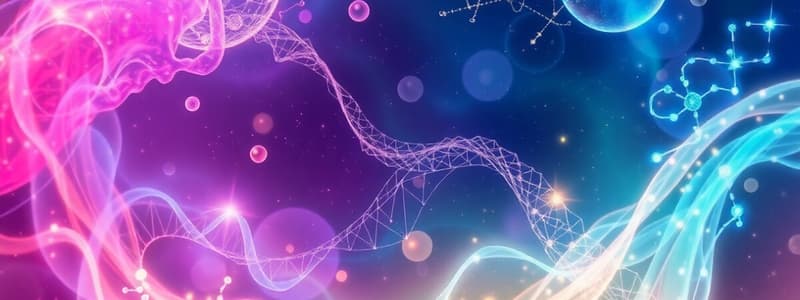Podcast
Questions and Answers
What role do enzymes play in chemical reactions according to Transition State Theory?
What role do enzymes play in chemical reactions according to Transition State Theory?
- They convert substrates into products directly.
- They stabilize the transition state. (correct)
- They add extra energy to the reactants.
- They slow down the reaction rates.
Which of the following best describes the function of lysozyme?
Which of the following best describes the function of lysozyme?
- It breaks down peptidoglycan in bacterial cell walls. (correct)
- It serves as a substrate for protein synthesis.
- It binds to iron to support oxygen transport.
- It enhances the growth of bacterial cells.
What are the two primary factors that influence enzyme kinetics according to the content provided?
What are the two primary factors that influence enzyme kinetics according to the content provided?
- pH and substrate concentration. (correct)
- Temperature and color change.
- Pressure and volume of reactants.
- Light exposure and enzyme concentration.
In the context of enzyme action, what is the significance of substrate binding?
In the context of enzyme action, what is the significance of substrate binding?
What is the importance of the Induced Fit Model in enzymatic reactions?
What is the importance of the Induced Fit Model in enzymatic reactions?
Which statement is true regarding the transition state in reactions catalyzed by enzymes?
Which statement is true regarding the transition state in reactions catalyzed by enzymes?
Which mechanism does an enzyme use to promote the formation of the transition state?
Which mechanism does an enzyme use to promote the formation of the transition state?
What is a significant feature of enzymes compared to other catalysts?
What is a significant feature of enzymes compared to other catalysts?
What is a primary function of lysozyme in the human body?
What is a primary function of lysozyme in the human body?
Which model describes how an enzyme binds to a substrate by distorting it into a transition state?
Which model describes how an enzyme binds to a substrate by distorting it into a transition state?
What does Km represent in enzyme kinetics?
What does Km represent in enzyme kinetics?
Which factors affect enzyme reaction rates according to enzyme kinetics?
Which factors affect enzyme reaction rates according to enzyme kinetics?
In the context of the Induced Fit Model, what happens when glucose binds to hexokinase?
In the context of the Induced Fit Model, what happens when glucose binds to hexokinase?
What is Vmax in enzyme kinetics?
What is Vmax in enzyme kinetics?
Which statement accurately reflects the role of the active site of an enzyme?
Which statement accurately reflects the role of the active site of an enzyme?
Which of the following best describes Transition State Theory?
Which of the following best describes Transition State Theory?
Which of these factors would NOT typically affect enzyme kinetics?
Which of these factors would NOT typically affect enzyme kinetics?
How does substrate concentration influence enzyme kinetics?
How does substrate concentration influence enzyme kinetics?
What is the definition of one International Unit (U) of an enzyme?
What is the definition of one International Unit (U) of an enzyme?
In non-competitive enzyme inhibition, which of the following statements is true?
In non-competitive enzyme inhibition, which of the following statements is true?
What characterizes allosteric regulation in enzymes?
What characterizes allosteric regulation in enzymes?
Which factor does NOT affect enzyme kinetics?
Which factor does NOT affect enzyme kinetics?
What mechanism describes the binding of a substrate to an enzyme where the enzyme changes shape to fit the substrate?
What mechanism describes the binding of a substrate to an enzyme where the enzyme changes shape to fit the substrate?
How does a competitive inhibitor affect enzyme activity?
How does a competitive inhibitor affect enzyme activity?
Which of the following statements accurately describes transition state theory?
Which of the following statements accurately describes transition state theory?
What describes the effect of cimetidine on the metabolism of steroids?
What describes the effect of cimetidine on the metabolism of steroids?
Which statement accurately describes enzyme kinetics?
Which statement accurately describes enzyme kinetics?
What is the primary role of lysozyme?
What is the primary role of lysozyme?
Flashcards are hidden until you start studying
Study Notes
Lysozyme
- Found in tears, saliva, human milk and mucus
- Part of the body’s innate immune system
Transition State Theory
- Enzymes reduce the activation energy of a reaction by binding to the transition structure and stabilising it
Induced Fit Model
- The enzyme and substrate fit together perfectly
- Upon binding, the substrate can induce a conformational change in the enzyme which may enhance catalytic function
- Active site: pocket of amino-acids that bind substrate or play a role in catalysis
- Example: Hexokinase; Binding of glucose causes two protein domains to close together, effectively closing the binding cleft
Enzyme Kinetics
- Rate of reaction is affected by temperature, pH and substrate concentration
- Rate of reaction is reflected by the slope of a graph, the enzyme capacity is the hight of the curve
- Vmax is the maximum rate of reaction and is dependent on enzyme concentration
- Km refers to the substrate concentration at which the enzyme converts substrates into products at half its maximal velocity
- Km reflects the affinity of the substrate for the enzyme
- Enzymes are the most efficient catalysts known
Practical Units of Enzyme Measurement
- Activity of an enzyme = ‘specific activity’ = μmol / min / mg - Micromoles of substrate converted to product per minute per milligram of enzyme protein
- International Unit (U) / ml - 1U = the quantity of enzyme which catalyses the conversion of 1μmol of substrate to product per minute under a defined set of optimal conditions
- katal (kat) - Amount of enzyme that converts one mole of substrate to product per second
Enzyme Inhibition
- Competitive Inhibition:*
- Inhibitor binds reversibly to the active site
- Km increases
- Vmax remains unchanged
- Non-competitive Inhibition:*
- Inhibitor binds outside of the active site, decreasing the reaction rate
- Km remains unchanged
- Vmax decreases
Allosteric Regulation
- Usually multi-subunit proteins with multiple active sites
- Involves the binding of regulatory molecules at sites other than the active site which then mediate conformational changes in the enzyme
- These changes may either enhance or inhibit catalytic activity
Clinical Relevance
- Drugs may compete for the active site of a single cytochrome P450 enzyme
- This can lead to variable effects on drug metabolism, especially for patients receiving multiple drugs
- Cimetidine (inhibits stomach acid production):
- Binds competitively to several cytochrome P450 enzymes
- Reduces the metabolism of endogenous and administered steroids
Transition State Theory
- Lysozyme breaks down peptidoglycan in bacterial cell walls
Studying That Suits You
Use AI to generate personalized quizzes and flashcards to suit your learning preferences.




